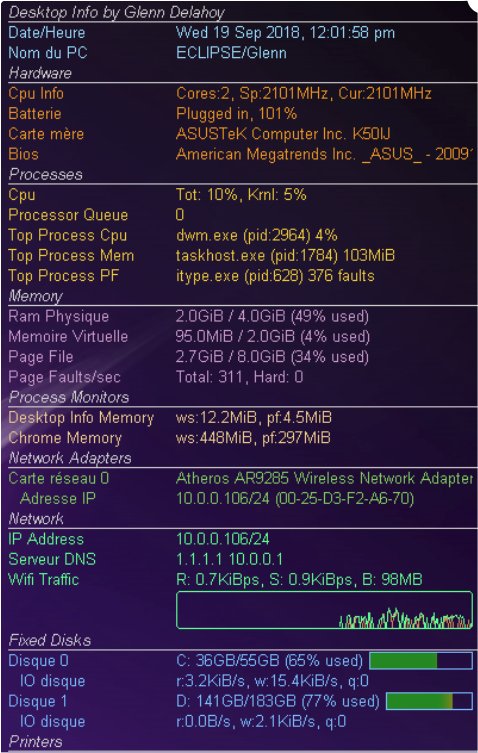Desktop Info is a utility designed to display crucial system information directly on your desktop, functioning similarly to various desktop information tools. One key differentiator of Desktop Info is its ability to remain resident in memory, continuously updating the displayed information in real time without consuming CPU resources. The application is lightweight, at approximately 840KB, and its appearance mimics wallpaper, making it an ideal choice for quick identification and monitoring of production or test server farms.
The information displayed by Desktop Info includes essential metrics such as time, host name, user identity, CPU usage, operating system details, memory usage, network statistics, disk usage, and even event logs. Users can customize the display settings to suit their preferences, including item selection, positioning, font styles, colors, sizes, and refresh intervals.
In addition to its core features, Desktop Info can be an invaluable tool for system administrators and technicians who require immediate access to system performance indicators without needing to navigate through multiple applications. Its minimalist design and customizable interface make it suitable for various environments, from individual workstations to expansive server farms.
For those looking for more information on hardware identification and system specifications, additional resources are available, including guides on determining motherboard details, processor specifications, and serial numbers for Windows PCs.
Further Enhancements and Use Cases:
To enhance the functionality of Desktop Info, future updates could introduce features such as:
1. Integration with Cloud Services: Allowing users to monitor remote servers or cloud-based systems directly from their desktop.
2. Alerts and Notifications: Implementing a notification system for critical thresholds—like CPU usage spikes or low disk space—could help users take timely action.
3. Mobile Compatibility: A mobile app version could extend monitoring capabilities, enabling users to check system stats on the go.
4. Data Logging: Adding the ability to log historical data could assist with performance analysis and troubleshooting over time.
5. User-Defined Widgets: Allowing users to create their own widgets to display custom data or metrics could further enhance the personalization of the tool.
By incorporating these enhancements, Desktop Info could evolve into an even more powerful monitoring solution, catering to the diverse needs of its user base
The information displayed by Desktop Info includes essential metrics such as time, host name, user identity, CPU usage, operating system details, memory usage, network statistics, disk usage, and even event logs. Users can customize the display settings to suit their preferences, including item selection, positioning, font styles, colors, sizes, and refresh intervals.
In addition to its core features, Desktop Info can be an invaluable tool for system administrators and technicians who require immediate access to system performance indicators without needing to navigate through multiple applications. Its minimalist design and customizable interface make it suitable for various environments, from individual workstations to expansive server farms.
For those looking for more information on hardware identification and system specifications, additional resources are available, including guides on determining motherboard details, processor specifications, and serial numbers for Windows PCs.
Further Enhancements and Use Cases:
To enhance the functionality of Desktop Info, future updates could introduce features such as:
1. Integration with Cloud Services: Allowing users to monitor remote servers or cloud-based systems directly from their desktop.
2. Alerts and Notifications: Implementing a notification system for critical thresholds—like CPU usage spikes or low disk space—could help users take timely action.
3. Mobile Compatibility: A mobile app version could extend monitoring capabilities, enabling users to check system stats on the go.
4. Data Logging: Adding the ability to log historical data could assist with performance analysis and troubleshooting over time.
5. User-Defined Widgets: Allowing users to create their own widgets to display custom data or metrics could further enhance the personalization of the tool.
By incorporating these enhancements, Desktop Info could evolve into an even more powerful monitoring solution, catering to the diverse needs of its user base
Desktop Info 3.19.1 released
Desktop Info displays system information on your desktop in a similar way to some other desktop information tools.


